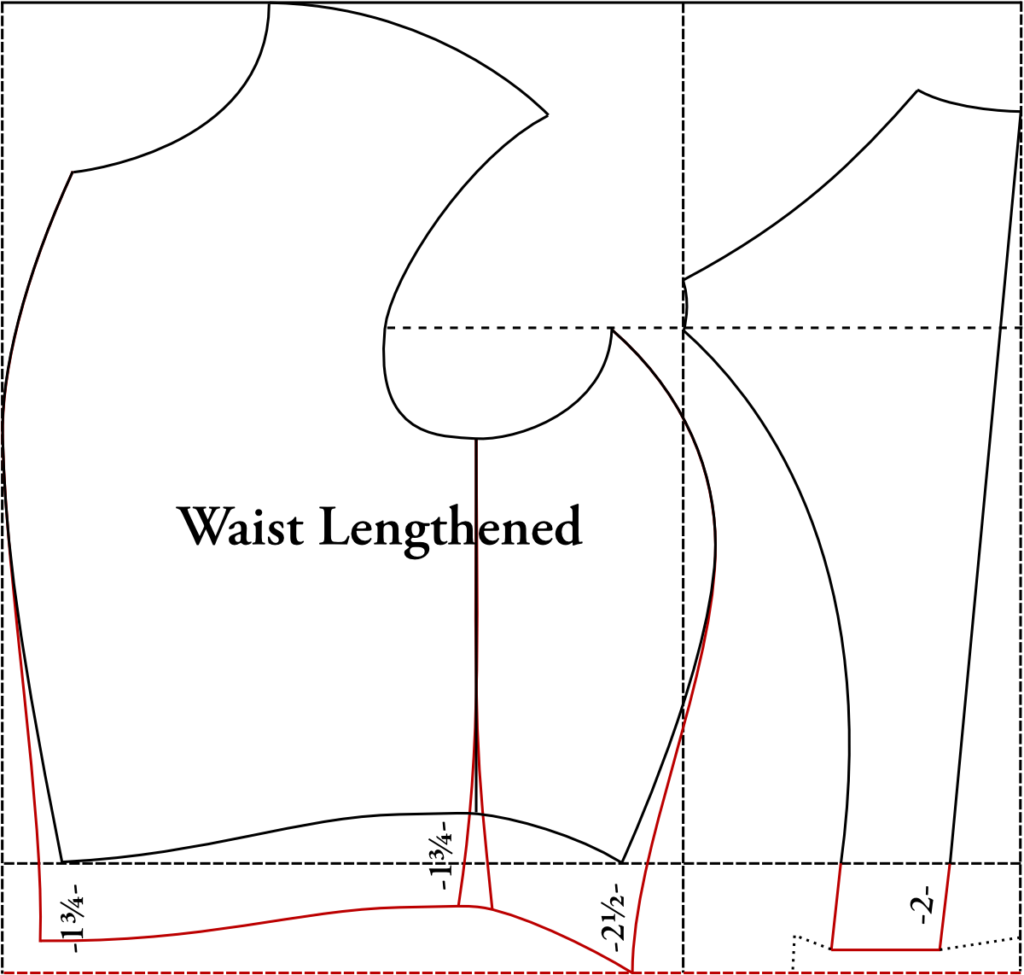Category: Drafting Frock Coats of the 1860s
Single and Double-Breasted Lapels
The Lapel – Double Breasted
We will begin the completion of the coat body draft by drafting the lapel. This particular style of lapel is for a double breasted frock coat, known as a cut-on lapel. This simply means that the lapel is cut separately from the forepart, and sewn on.
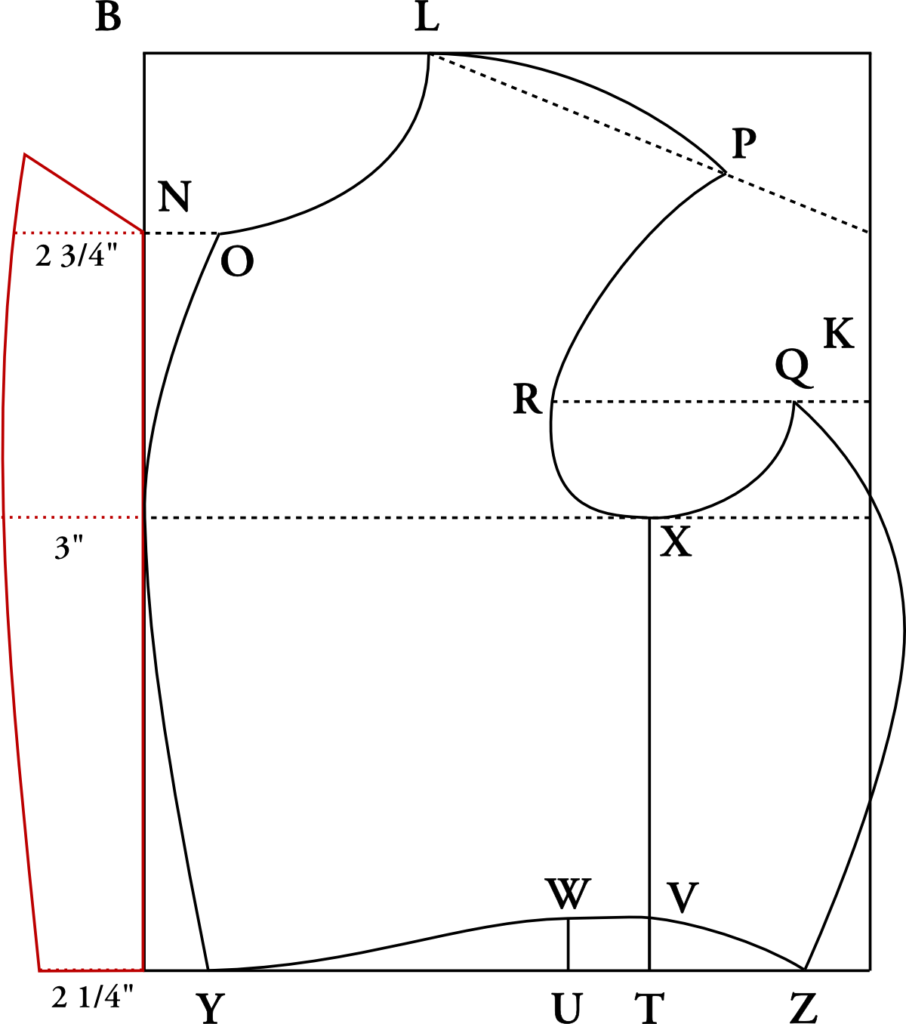
To begin drafting, mark the height of the lapel from point N to the bottom of the drafting square.
Next mark out the widths: 2 3⁄4 graduated inches at the top from N; 3 graduated inches from the chest line, and 2 1⁄4 graduated inches at the bottom.
The outer edge of these three points are connected with a graceful curve.
At the top, extend the curve as much as necessary to get the shape you desire, then draw a straight line diagonally at the top, connecting to N.
The top angle is variable according to fashion. You should study the photo or fashion plate you are copying, and try to match that as best you can.
The Lapel – Single Breasted
For drafting a single breasted coat, with a grown on (the lapel is connected to the coat body) lapel the following instructions are followed. This involves less sewing, since the lapel is already attached to the coat front.
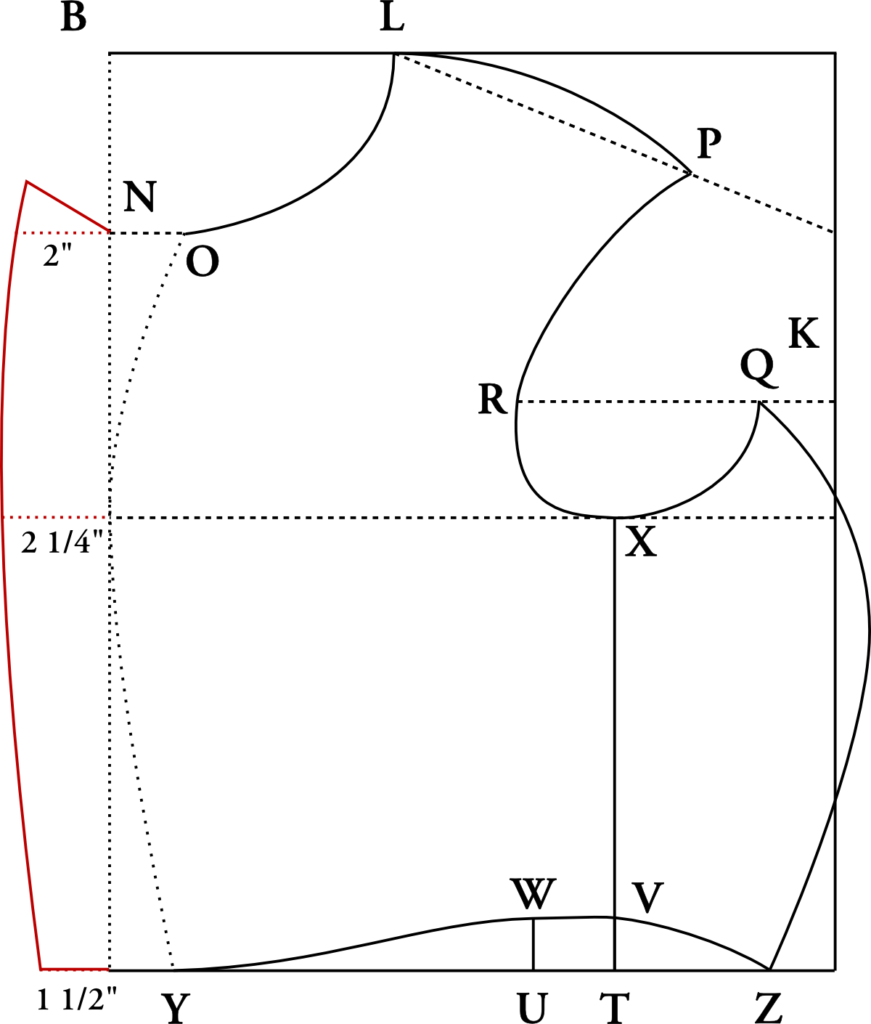
From the construction line at point N, measure out 2 graduated inches for the top of the lapel.
At the chest line, measure out 2 1⁄4 graduated inches from the center front.
Draw a graceful curve connecting these three points, extending a little above the top point as desired. Shape the top of the lapel as shown, according to your fashion needs.
At the top of the coat, a large dart is formed from the center front at the neckpoint, down to where the coat meets the lapel, and straight up to the top of the lapel.
At the waist, measure 1 1⁄2 graduated inches inches, and extend the waistline to meet the rest of the coat as shown.
Linen or Silk Coats
Due to the nature of linen, silk, and cotton, ironwork is not possible. These fabrics do not hold their shapes when stretched, making any efforts fruitless. To account for this, changes must be made in the pattern itself.
Devere’s basic coat draft is made with what’s called a crooked shoulder. If the coat is left like this without ironwork or other corrections, you’ll get folds of fabric along the front of the shoulder, and the coat will hang open at the fronts. You may have noticed this on reproductions you’ve seen, as well as some lesser quality originals.
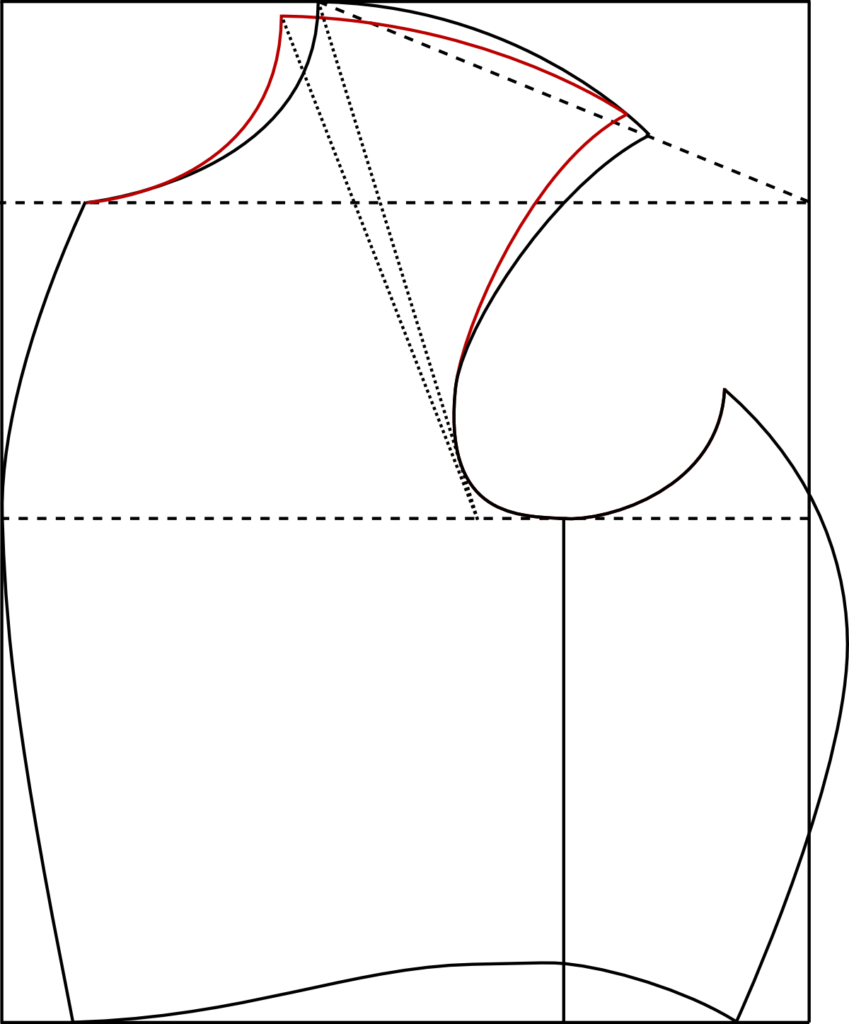
To fix this, first move the point where the shoulder meets the armscye over 3⁄4 graduated inches. The point should stay on the original shoulder line – it’s just being moved over. At the other shoulder point, where it meets the neck seam, you must move this over 3⁄4 graduated inches as well. However, this point must also be lowered about 1⁄4 inch. If you measure from the front of the scye at the chest line, to the original shoulder point, and to the new shoulder point, they must be the same. If you don’t drop the shoulder point, this will be off, and you will have an ill fitting coat.
Armscye Dart for Other Fabrics
Another benefit of ironwork is the shape that is added to the coat. The shaping will give a very close fitting armscye, and produce roundness in the chest.
Since we are not able to perform the ironwork on linen, silk, or cotton, darts must be used in its place. Beginning at a point at the fullest point of the bottom front armscye, draw a construction line about 2 1⁄2 graduated inches long, as shown by the dotted line. At the base of this line, at the armscye, mark 1⁄4 inch on either side of the dotted line, and connect these two points to the other end of the line, forming your dart. These are the actual seam lines where you will sew later on.
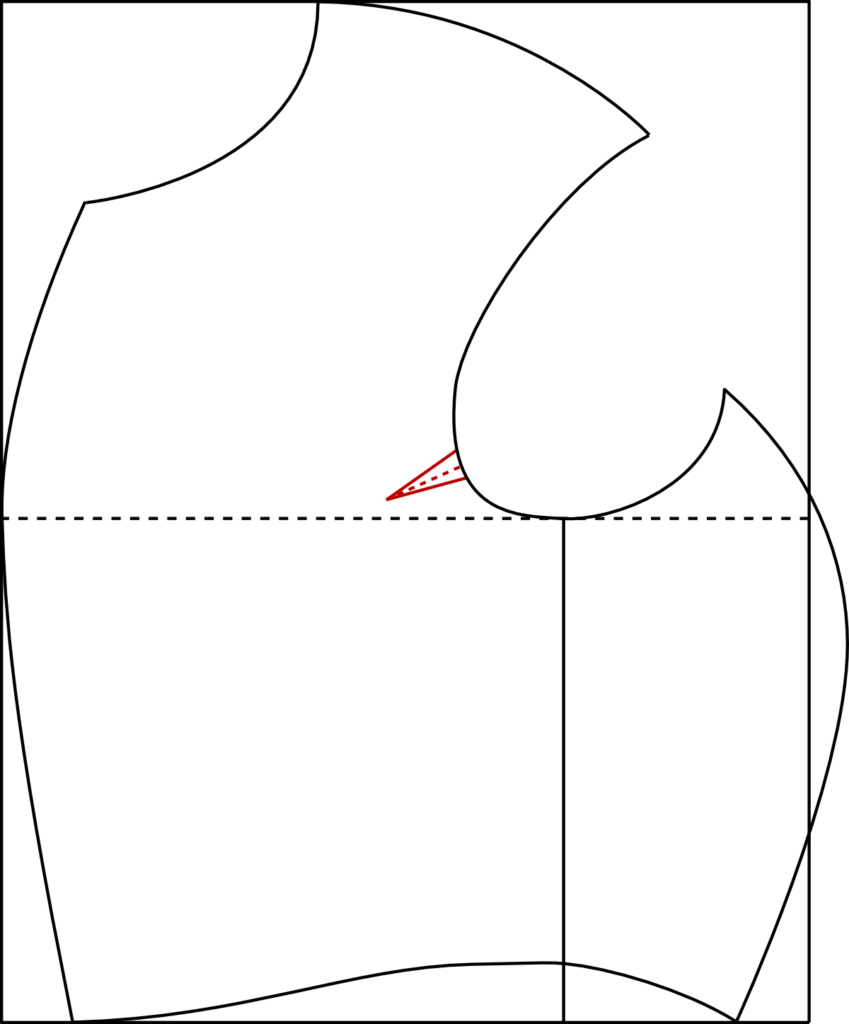
Iron Work for Wool Coats
Ironwork seems very intimidating to most people, as very few tailors, save the bespoke tailors on Savile Row, and some others, still practice it. The style of ironwork done in the period is almost unheard of. I know it was one aspect of tailoring that took me years to figure out. I didn’t have anyone to just show me though, and had to learn it through books and lots of practice.

It’s a good idea to do most of the stretching on your muslin wrapper. Even though it will not stay permanently, it will give you a better idea of how the final fit will be. Shrinking will not work on the cotton muslin, so you’ll have to train your eye to recognize the adjustments needed.
If you skip the ironwork, you’ll end up with long vertical folds near the shoulder and front of scye, and the chest will not be full enough to contain the padding we will be inserting. The front of the coat will drape open, a problem often seen.
The following text comes from Practical Tailoring, The Art and Craft Simply Explained for the Student and Apprentice, by J. E. Liberty. He gives the clearest instructions for ironwork I have found yet.
Shrinking to Shape.
The material should be laid on the board and a little water applied with the fingers of the left hand, the part to be shrunk being nearest the worker. Place the iron first at the back of the material at a part where the shaping will begin, and working it from right to left and towards the front, work round the part being shrunk with the fingers of the left hand while the iron is moving. It will be seen that the shrunk section probably has one or two small pleats formed by trying to shrink too much at once, and these should be smoothed out by putting a little water on the creases and passing the iron over them. It should not be necessary to go over the shrunk part more than twice to obtain the shape required, as too much shape will not hold in the cloth, and should be taken out be seams in the cutting of the garment.
Stretching.
In stretching the process is similar to that used in shrinking, except that the material is worked out instead of in. It should be remembered that in shrinking into shape, the material will, after a time, return to its normal shape, but with stretching, it seldom, if ever, does ; also that to obtain length by stretching naturally reduces the width, and this must be allowed for in cutting.
Forepart
We will begin our ironwork by taking up the forepart, and stretching the front of the armscye. The total amount of stretching should be about 3⁄4 of an inch. Hold the fabric at the shoulder point, and put pressure down with the iron, stretching as you go. Both layers of fabric should be stretched at the same time, to ensure they are stretched equally.
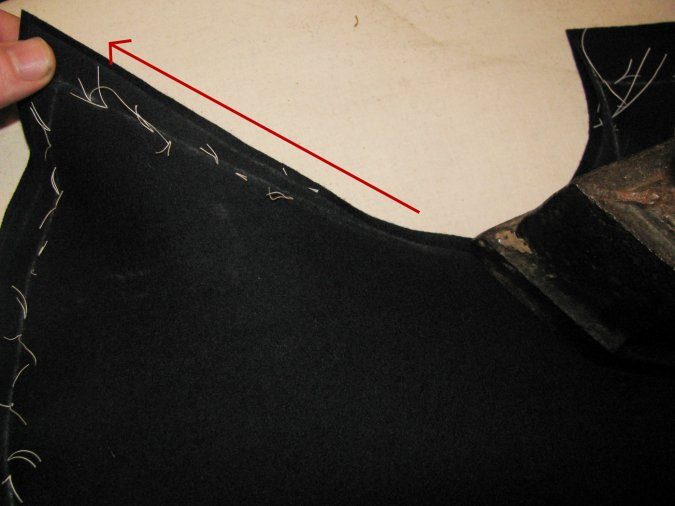
Next, stretch the shoulder seam, about a quarter inch total. This is one of those steps not explained in any book, but learned only through practice and critical thinking. If you measure the distance from the edge of the shoulder seam, and compare that to the edge of the back shoulder seam, you will see they are equal. If you add a seam allowance to that, there is no problem getting them to line up. This is what the majority of produced patterns do. Remember, we did not add a seam allowance, so instead, measure the distance of both seams, 1/4” from the edge. You’ll find that the back seam is 1⁄2” to 3⁄4” longer. By stretching the front shoulder seam, and shrinking the back shoulder seam, this distance is reduced, and the seams line up much closer. Now, stretch the hollow point of the neck seam only, about a 1/4” as well. This gives a little more shape to the shoulder area, and helps the neck hug the body more closely. Stretch the side seam as well, about 1/4”. This is not shown by Devere, but necessary to get the seam to line up with the side piece.
The center front needs to be shrunk, now. Notice how the center front is curved. You will need to shrink this carefully so that it is turned almost into a straight line. Please see the video for a demonstration of this and the other techniques.
Sidebody
The goal of the ironwork on the side piece, is mainly to impart more shape into the coat. In this step you are basically folding the fabric over, and stretching the seams, while shrinking the middle. It will take some practice, but you will get it. Try not to crease the middle of the piece as you’re doing the ironwork, as it’s hard to get rid of.

The following is a description from The Art of Garment Making, by Phillip Dellafera.
Fold the sidebodies as indicated, then proceed by shrinking away all the ‘loose’ material that will show itself at the waist. This work must be done carefully, until a nice hollow is formed at the waist; it will then be seen that the outer edges will have become slightly stretched. This is exactly what is required, and it will be found that a well-defined waist is obtained by adopting this method.
Sometimes this effect is obtained by slightly stretching the seams in a downward direction only. This, of course, will certainly help to get the desired shape; but the best plan is to shrink the centre of the side body, which will automatically give the extra length to the seams.
Also, stretch the bottom of the side piece slightly, again about 1⁄4”.
Here’s a video of the entire process showing the ironwork I usually do on a frock coat.
The Crooked Cut
Devere’s system of drafting gives us what is called a ‘crooked’ style of coat. What this means is that the distance of the neckpoint from the front of scye is greater than say, a coat cut from today’s patterns.
Notice how the first draft, from the 1840s, is extremely crooked in the shoulder.
Next, we see Devere’s draft, which still has the crooked shoulder, but not as severe.
Finally, there is a draft from Rundschau, 1959, a German cutting magazine still published today, showing the straight cut shoulder.

The benefit of the crooked cut is that when properly worked up with the iron, you will get a closer fitting armsye, and more fullness in the chest. This gives us the period ‘pigeon-breasted’ look that is so often missing from reenactor’s impressions. Compare your store-bought patterns, if you have them, to your draft from Devere’s, and see if the shoulder is similarly crooked. Because the shoulder is so crooked, it must actually be straightened either with the ironwork – in woolen coats only – or by a series of darts in the paper pattern, which in turn will give us the shape and fit we are looking for.
Adjustments to the Toile
Now that you have read through all of these fitting and alteration problems, take a close look at your toile, and pick out any errors you may find. You can’t catch all of them with just the basic toile, so there may be a few to catch in the next fitting stage. For now, focus on making sure the following fit correctly.
Center Front
Make sure the fronts meet. The fronts at the chest level will overlap slightly due to the curvature of the front. Measure the distance that the front is off at the waist, and add or subtract half that amount on the draft, as shown for Thin or Stout waists. Check the neck measurement, subtracting if necessary from the draft as shown.
Long or Short Bodied
Measure how long the pattern should be lengthened or shortened, and make the appropriate corrections on the draft. The fabric should come down to about an inch below the waist, rise up a little for the hips, and lower again in the back. I suggest lowering the back a little extra, to make room for the belt above the plait buttons.
Balance
Check the back neck. If the balance is too long in the back, there will be folds behind the neck. If too short, there will be a gap. Measure the distance it is off and make the appropriate corrections on the draft.
Please post photos of yourself from the front, side, and back if you would like help in fitting. The better quality the photos the easier it is to correct things. If there are corrections to be made, make those on your original pattern, trace to a new sheet of pattern paper, and cut out and construct a new toile to test your alterations.
Neckpoint Alterations
The neck is not a measurement taken in Devere’s system, but perhaps it should have been. When drafting, the neck is drawn in proportion to Breast size. However, when you get to larger sizes, starting at around size 46, this drafting method starts to break down. A correction is to take half the difference between the proportionate neck and your own neck measurement, and correct the pattern as shown in the diagram. This will give you a closer fitting collar and front.
For example, if you have a size 48 chest, use the following formula. 14.5 is the proportionate neck size:
14.5 * (48 / 37.5) = 18 5/8
Check that against your actual neck measurement, say 16 5/8. The difference between 18 5/8 and 16 5/8 is 2. Take half of that measurement, since we only draft one side, and move the neck point in that amount as shown, and rotate the center front curve backwards.
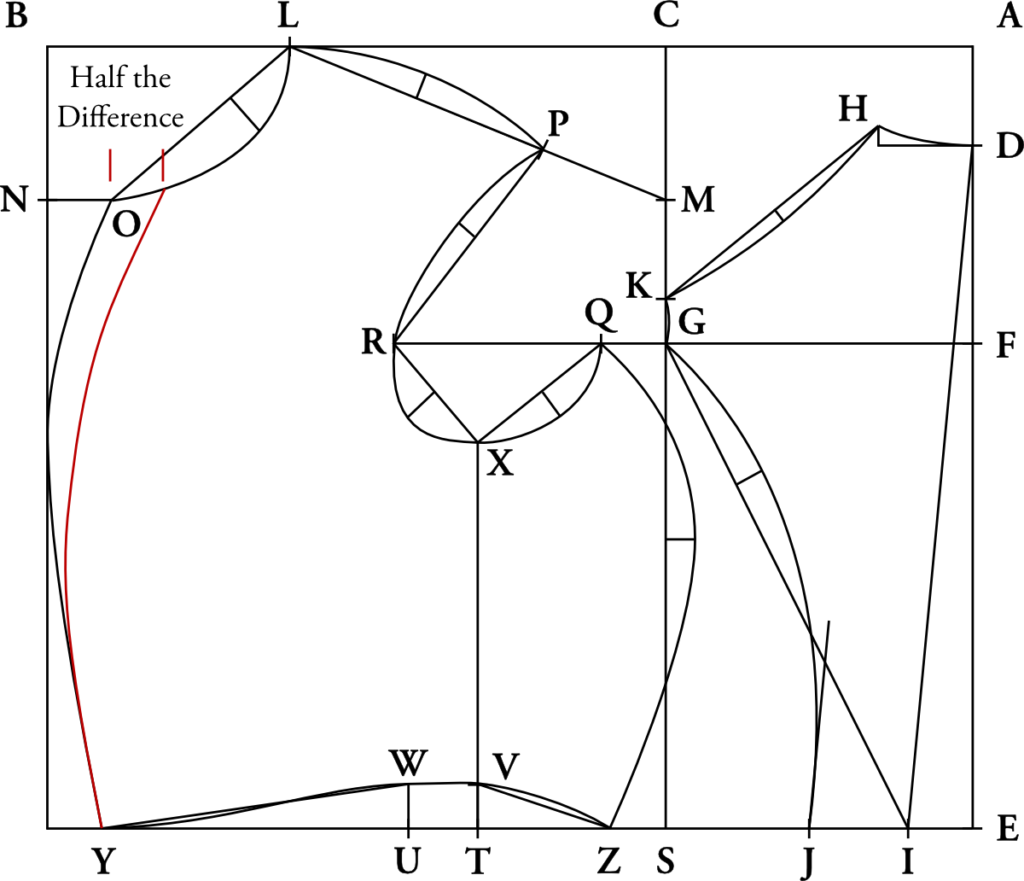
Misfits
Shoulder Piece too Backward
Sometimes called Forepart too Crooked. This error in the cut, causes the front edge of forepart to droop or fall away, which is one of the defects most frequently met with. The coat fits well otherwise, but when unbuttoned, the front part is seen to fall away. When buttoned, the crease edge and the neck appear too long. This may sometimes happen even when the cut is perfectly correct, if the workman has stretched the neck in making up, or (which is the same thing) has put on the collar too long.
If the fault is in the cut, the best way is to join a corner on the shoulder piece, and then cut it straighter and shorter, as shown. If the fault arises from the making up, it will be best to take out a fish in the neck seam as shown.

Shoulder Piece Too Straight
When the shoulder point of forepart is brought too forward, the coat will crease at the front of scye, which seems to require hollowing out a little; and the coat will also appear too tight at the neck, and at the back of waist.
The most natural way of correcting this, is of course to take back the shoulder point as shown, but this cannot be done unless (which rarely happens) there has been a laying in left at the top of scye. Fig. 4 shows another plan, which consists in hollowing out the front of scye, and bringing back the diameter of arm to its proper width, by taking out a under the arm, gradating to nothing at the hip. This will of course have the effect of narrowing the chest, and if the coat is to be worn buttoned, the buttons must be taken forward to compensate it.
The two misfits that we have just described, will never be found in any pattern drafted by our system, unless it has been carelessly made up. Workmen are very careless about the neck stretching, and to obviate this, we advise all cutters to cut out the collars to the proper length, as explained on plate 25, and to tack a piece of stay tape round the neck seam, which is not to be removed until the time for putting on the collar.
All the misfits that we are now about to describe, both in the Forepart and Back, may be termed faults in the balance, and are caused by cutters attempting to draft without the measures of Bust and Curve. When these measures are not taken, it is a mere chance if the coat has the proper balance, and any error in the balance, however small, produces a corresponding defect in the garment. No amount of care, or of knowledge and experience of structure, can compensate for the chance of error, which arises from neglecting to take the two simple measures called bust and curve.

Shoulder Piece too Long
This error like fig. 3, causes the front edge to fall away when the the coat is worn unbuttoned. Besides this, it does not touch at the back part of waist, and forms a long fold in front of the arm. When buttoned, the coat fits well at the back, but creases all across the chest, on account of the extra length of shoulder piece.
The most natural way of remedying this fault, is to shorten the shoulder piece, as shown by fig 5, but this can not be done if there is no laying in at the top part of the armhole. Again if the garment is finished, this manner of alteration becomes impossible, as the lapel cannot be shortened. The coat therefore, must then be corrected as shown on Fig. 6, C, by joining in a piece at the bottom of the scye, sewing the side piece higher up, and cutting off the extra length at the bottom of forepart.

Shoulder Piece too Short
This error causes the front to draw up, and to be very tight on the chest and round the armhole, and has the same effect, whether the coat is buttoned or not.
If there has been a good laying in left at the neck and top of the shoulder, this misfit is easily corrected, as shown by fig. 7. If not, the correction D, shown on fig. 8, will do equally well. Lower the bottom of scye in the forepart, stitch the side piece lower, and cut superfluous length at the bottom of side.

Back too Long
This misfit is easily distinguished from all others. The fronts fit perfectly well buttoned or unbuttoned; but the back forms creases crosswise, between the shoulders and at top, and with the fingers a large fold can be formed across the back, between the shoulders.
The back might be shortened, as shown on E, fig. 1, but as this plan reduces the width of back stretch, it can only be used if the back is too wide as well as to long. The correction E, shown by fig. 2, will have the same result, and is that which is generally the most suitable.
Lower the back a little at top; lower the side point, and sew the back lower with the side piece, cutting it across at the waist, to separate the back skirt, and removing the extra length from the bottom of back.

Back too Short
When the back is too short, and the coat is unbuttoned, the shortness of the back drags the front edge backward, the bottom of back stands out from the body, and appears as if the coat was immensely too large at this part. It also drags a little at the shoulder, and in front of the scye. If the coat is buttoned, it will fit tolerably well at front, but the neck seam is too low behind, the collar stands out from the neck, and the back is instantly seen to be deficient in length.
The proper way of correcting this fault, is of course that shown on fig. 3, but as this can hardly ever be done, the correction indicated by fig. 4 must be made. Join in a piece, so as to raise the side point (or else cut fresh side bodies), and lower the notch at waist, so as to give more length to the back, of course cutting off the bottom of front skirt, to compensate for the necessary shortening of the back skirt.

Variations in Shoulders
The changes that are met with in the form of shoulders, require corresponding alterations to be made in the form of the scye. These changes seem at first rather complicated, but will be found very easy to understand, when classified under the three heads of Depth, Height, and Width.
Louis Devere
Depth of Scye
The depth of the bottom of scye may be more or less, if the shoulder is high or low, large or small. It’s place is ruled exactly, by the measure of Side.

It might sound counter-intuitive, but a close fitting armscye will be both more comfortable and give you more flexibility than a looser armscye. Take a look at a modern coat, for instance. Unless it is very well made, you will find it has a very deep armscye, and when you lift your arms, the sides of the coat will go with it.
On a coat with a properly fitted armscye, the fabric will go right up to the armpit. When you lift your arms, the coat has nowhere to go, so will remain at your sides.
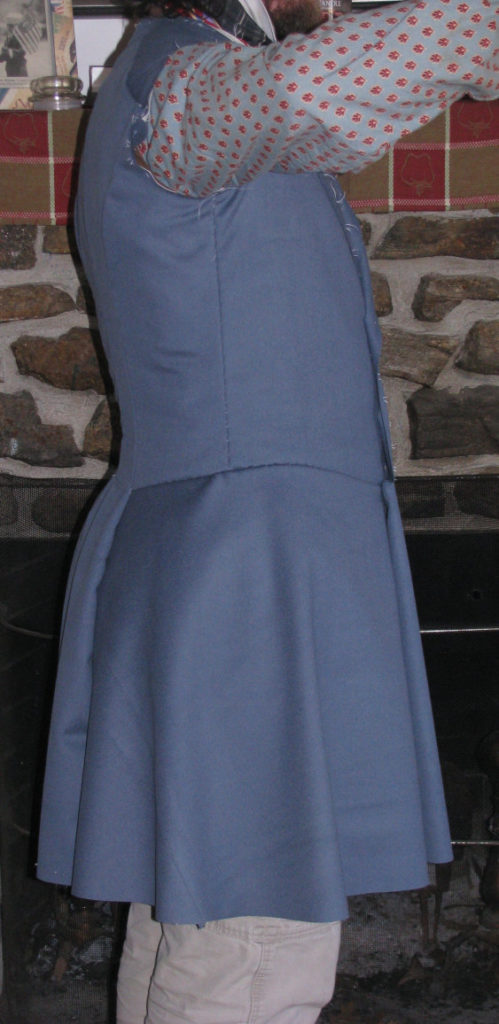
Height
The slope of the line which rules the shoulder seam, varies according as the shoulders are high or low, because this slope of this line is always ruled at double the Slope measure, starting from 0 along the construction line. It sometimes is found not to be the same in the right and left shoulders of the client; when it varies, this part of the pattern must be drafted separately for each client.

Width
The scye may be more forward or backward, if the shoulders are large or small, forward or backward. The exact position of the front of scye is ruled by the measure of Diameter, starting from the side point, which is always kept at a fixed base.

Changes in Fashion
Neck Point Higher or Lower
This is an alteration often required by fashion; care however must be taken not to fall into extreme degrees, either of raising or lowering it. It should rarely be higher than 3, or lower than 5 inches.

This is one of the most important areas to fit correctly, as it is in the front of the coat and noticed most easily. The Neckpoint should come just to the top of the sternum, the bone at the base of your neck. Too high and you’ll get unsightly folds along the front of the coat. Too low and you’ll have a gaping hole at the neck area.
On a coat with lapels, for example most civilian coats, this is adjustable, depending on how high you want the gorge line (where the lapel meets the collar) of the coat to be.
Back Wide or Narrow
The back if required may be made wider or narrower, provided that the same quantity which is added to or taken off from it, be compensated for in the side body, by either taking off or adding on equal quantities at the corresponding places, as shown on the diagram.
Back Neck Wide or Narrow and Back Scye High or Low

As a general principle it will not matter if the places of the shoulder and side seams are varied, provided always that the quantity taken away from one piece is added to the other. For instance, the back neck may be wider, provided we make the shoulder strap of the forepart shorter to agree with it.
The back scye may also be higher or lower, provided that a corresponding alteration is made in the side body, so as always to keep the side point on a level with the bottom of back scye. We must say, however, that these changes in the position of seams, should never be carried to extremes. There are certain places for the seams, which have been found by long experience to be those most suited for them, and these cannot be much deviated from in close fitting garments, without in some degree deranging the harmony of the cut.
Long and Short-Bodied Structures
Almost every coat will also need alteration in the length, if not for fit, then for fashion. Some people, such as myself, have longer torsos and require additional length.
And in general, coats were lengthened by an inch or so around the waist so as to be more fashionable.
The bottom of square being ruled by the length of back, (which is always taken as 1 1⁄2 less than the curve measure), the pattern will become of itself suited for the client, whether he is either a long or short bodied structure, or proportionate.
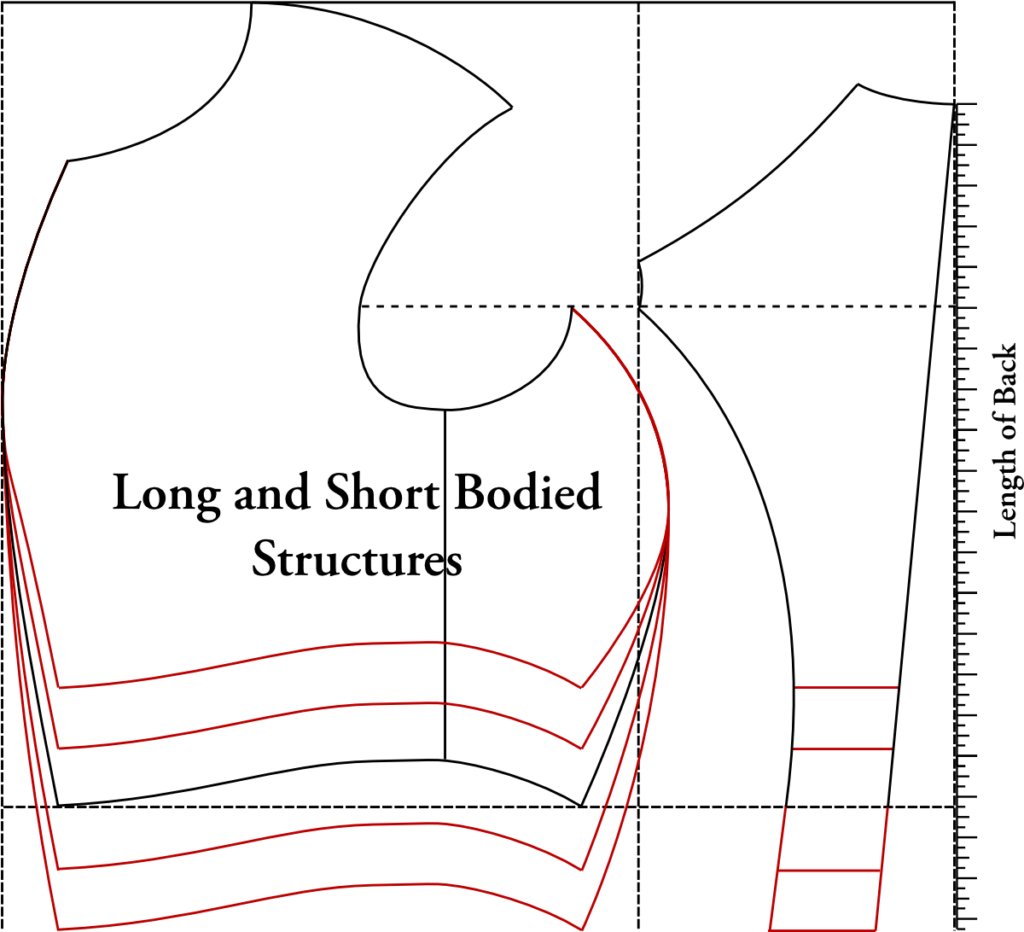
Long Waists
The draft of the long waisted back and forepart, is made in the regular square, and consists in simply prolonging all the seams, any required quantity below the natural waist. For this lengthening, the front edge and side seams must be slightly sprung out, so as to make them parallel to the sides of the square. The seam under the arm must also be sprung out more or less, according to the prominence of the hips; this will, of course, make the forepart and side body lay over each other at the bottom, and they must be cut seperate before laying the pattern on the cloth.
The figures at the bottom of the diagram, give an average or medium degree of lengthening. It will be seen that if the back is lengthened 2, the side body must be lengthened 2 3/8, or 2 1⁄2, because 3/8 or 1⁄2 an inch extra should always be allowed at this part, for the seam of back plait. The lengthening of the forepart, is usually a little less than that of the back
For Coats of the 1860s Period
During the 1860s, it was the fashion to extend the waist slightly below the natural waist. On a uniform, this is particularly important because you need to leave room for the belt to be placed just above the buttons. In the back, I’ll often lower the waist even further to ensure the plait buttons fall directly beneath the belt.
Whether for a uniform or a civilian frock coat, this is a very important step in order to get a period correct coat. Follow the measurements as shown in the diagram for a good basic fit.
